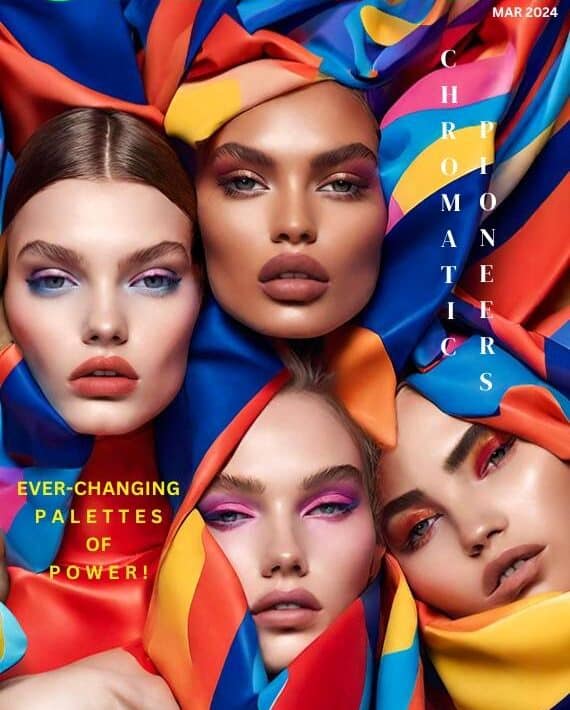From Past to Present: How ”The Zay Initiative” Threads Heritage into Today.

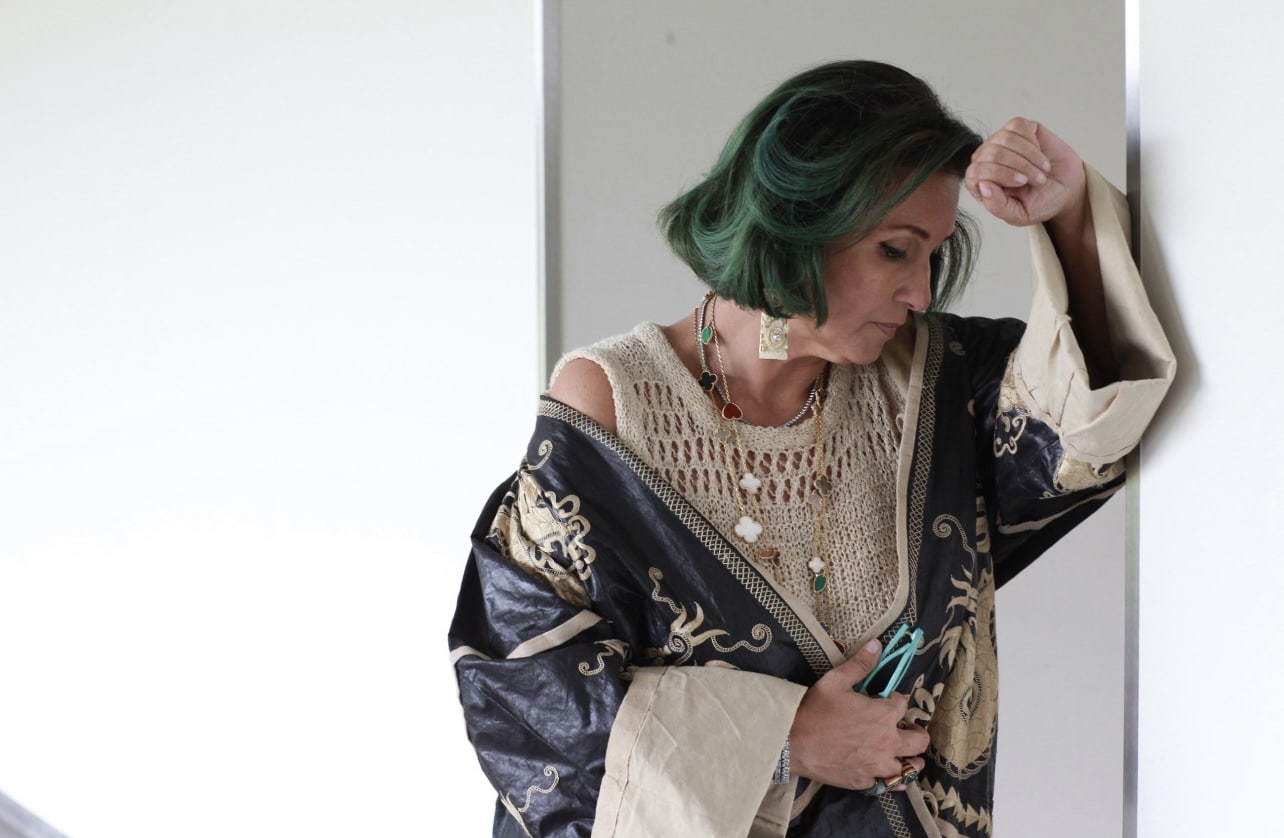
Understanding the Cultural Legacy of “The Zay” through the words of its founder Dr. Reem Tariq El Mutwalli.
Everywhere in the world there are treasures buried in oblivion, traditions deeply rooted in the culture of each country but so rarely spoken of because (maybe) incomprehensible to the eyes of those who only know progress and the speed of transformation. Yet, these treasures still exist, waiting to be rediscovered and handed forward across time, so that our heritage does not vanish like a drop of water in the sun but instead lends its luster to the present.
And there are people who dedicate their life to rediscovering our past, telling wonderful stories of times long gone and, just for this, full of richness and fascination.
This is how “The Zay Initiative” was born, years ago, in the sun of Dubai, thanks to its visionary founder Dr. Reem Tariq El Mutwalli, a published author and expert in art and cultural heritage. For over four decades she has been patiently and wisely uncovering ancient treasures born in the lands of the desert (and not only), investing in one-of-a-kind collection of historic dresses and fine accessories. The core of her archive is based on UAE traditional clothing, in addition to key examples from Yemen, Morocco, Kuwait, Iraq, Syria, Tunisia, Egypt, Bahrain, Qatar, Oman, Saudi Arabia and even China, Japan and Korea.
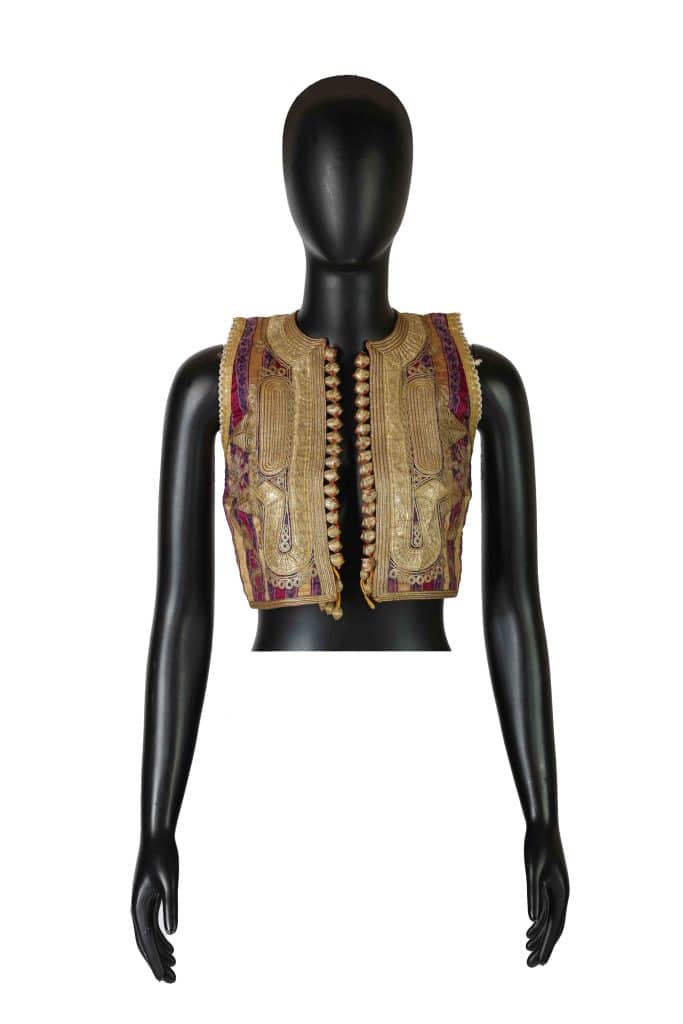

Metal embellished silk vest from Morocco and embellished undergarment with metallic straw from the UAE-Image Source: The Zay Initiative Archive

When Modernity meets Tradition. AI-generated outfit freely inspired to Moroccan Metal Embellished Silk Vest and to Emirati Embellished Undergarment with Metallic Straw from “The Zay Initiative – Archive”; Image Source: AI-Generated By Gazetta
“The Zay Initiative – Dr. El Mutwalli says – is a non-profit organization dedicated to collecting, documenting and digitally archiving the traditional dress of the Arab world, with a particular focus on women’s attire.
At its core, the Initiative is about dialogue. What’s often overlooked, is how much global cultures have historically been influenced by the Arab world – through language, design, trade and everyday customs. At the same time, Arab culture itself never developed in isolation. It has always evolved through contact – with Asia, Africa, Europe – adapting and integrating elements in a way that enriches its own heritage”.
At The Zay Initiative, the focus is on these exchanges, highlighting how cross-cultural encounters – both direct and indirect – shaped the way traditions took form regionally. This layered evolution is what gives Arab dress and craftsmanship their unique identity today.
“More than a collection of garments – Dr. El Mutwalli points out – The Zay Initiative is a space where memory is held and shared through dress. We live in a world that feels increasingly fast-paced and transactional, where so much is consumed and quickly forgotten. In the Arab world, the effects of conflict and rapid change have only made that loss more tangible, especially when it comes to the everyday objects that quietly carry meaning.
I once came across a hand-embroidered “thobe” (a long, ankle-length robe-like garment traditionally worn in many Middle Eastern and North African countries, Editor’s note), its silk threads softened with age, yet still holding the shape of its wearer’s life. It stayed with me, not because it was rare or ornate, but because it felt personal. Familiar. These pieces may seem simple, but they reflect entire ways of being.


Left: Silk brocaded waist cinched dress from Saudi Arabia; Image Source: The Zay Initiative Archive ; Right: The Ultimate Fashion Frontier: When the Future meets the Past. AI-generated outfit freely inspired to Saudi Silk Brocaded Waist Cinched Dress from “The Zay Initiative – Archive”; Image Source: AI-Generated By Gazetta
In preserving them, I’m not just holding onto fabric, I’m holding onto identity, quietly woven into every seam”.
It is often the quiet details that say the most. A stitched repair done carefully by hand. A lining embroidered just for the wearer’s eye. A colour choice that reveals a regional story or a personal one:
“Some garments have talismans tucked inside or prayers sewn along the seams. Others carry subtle shifts in technique that show how styles evolved through trade, migration, or need. These touches are rarely the first thing someone notices – but they’re often the reason a piece matters”.
Of course, as a collector, Dr. El Mutwalli has her own favourite pieces from her archive. These (unexpectedly) are not related to the Arab heritage but to the Eastern culture, Chinese and Japanese:
“I often say – half in jest – that I must have been Chinese in a past life. The Ming Dynasty (1368–1644) has always resonated with me: the restrained elegance of their garments, the harmony in their patterns, and the serenity of their blue-and-white aesthetic reflect a way of life grounded in intention and refinement.
We also preserve a number of Japanese kimonos – not as tokens of fashion, but as case studies in shared structure and sensibility. When placed beside the traditional Arabic “Abāyah”, these pieces reveal surprising parallels: both are robe-like, loose-fitting garments with wide sleeves and subtle layering. They speak to different aesthetics, yes – but also to shared values of grace and cultural identity.
It’s in these quiet crossovers – between East and West, past and present – that I find myself returning. The beauty of dress is that it moves. It travels, transforms, and connects us in ways we don’t always expect”.
But when asked, among the numerous pieces in her collection, which one feels most personal to her, then Dr. El Mutwalli has no doubt and her heart opens to a garment, not ornate but deeply familiar:
“There’s an Emirati “kandūrah” (typical Emirati man dress, Editor’s note) that belonged to my mother’s generation. Lightweight, soft cotton, gently discoloured from wear, yet featuring a “farukhah” (braided tassel) at the neckline – a small flourish popular in its own time.
Every time I look at it, I see her in the quiet moments of life: gathering family, preparing coffee, offering hospitality. It isn’t dressed for ceremonies—it’s a garment for living. The subtle presence of that farukhah speaks of modest individuality and regional identity.
This piece doesn’t need grand motifs to be meaningful. Although a man’s garment it reflects the quiet strength and dignity of everyday women – my mother among them—that gave this kandūrah and its wearer its power. These are the women who shaped homes, communities, and lives without fanfare. This piece means the world to me because it’s woven from the same cloth of memory and belonging”.
Authenticity is behind every single choice made for The Zay Initiative:
“It’s rarely about perfection, and almost never about opulence – Dr. El Mutwalli admits – I’m drawn to garments that carry stories—ones that feel like they’ve lived a full life. A small tear, a sun-faded motif, or a stitched repair can sometimes speak louder than pristine embroidery. These are the signs of a piece that belonged to someone, moved with them, and marked a moment in time.
We also regularly receive donations from families who want to see their heritage preserved and shared.
The Zay Initiative collects not just for display, but for dialogue. Even if we don’t yet know its full story, we preserve it with care – because in time, through research or connection, its meaning often reveals itself”.
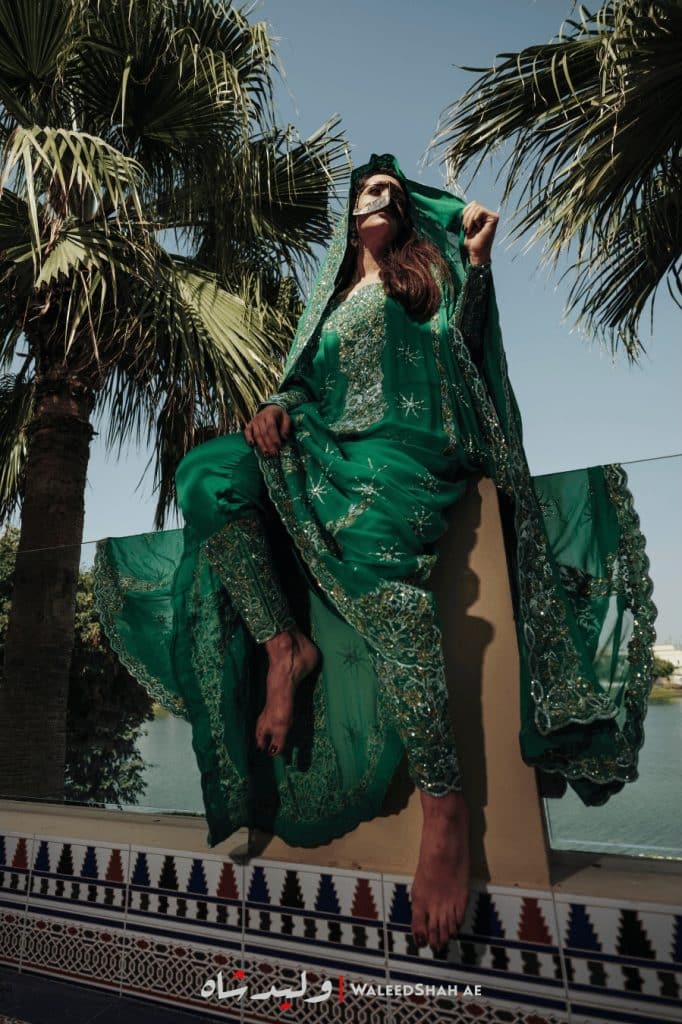
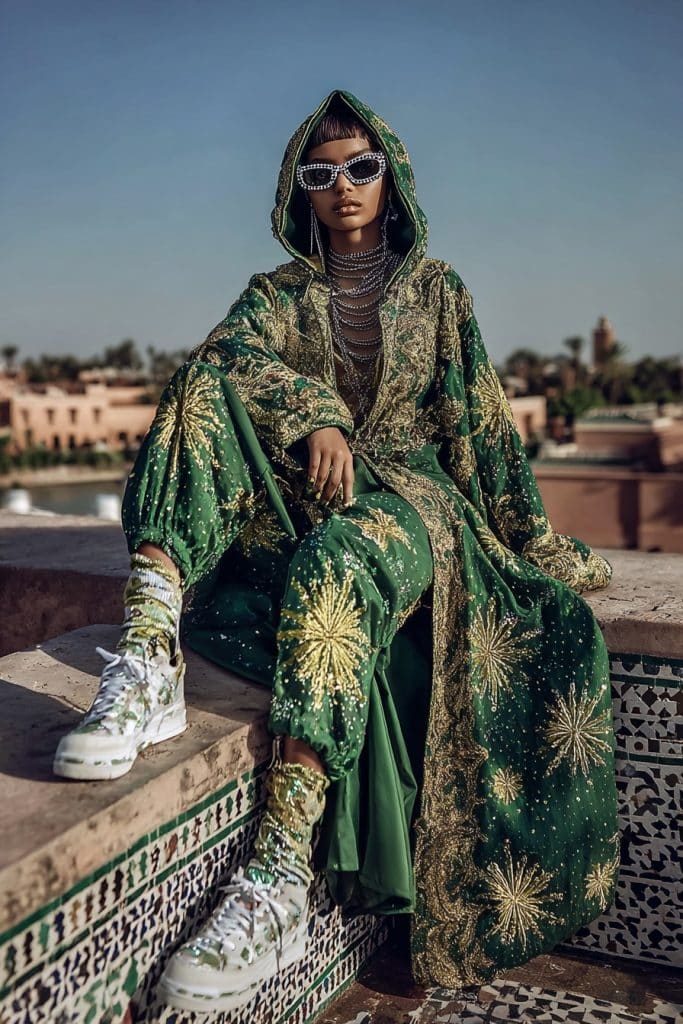
Left: Embellished combination overgarment tunic with train – Henna set from the UAE; Image Source: The Zay Initiative Archive Photographed By Waleed Shah ; Right: The Ultimate Fashion Frontier: When the Future meets the Past. AI-generated outfit freely inspired to Saudi Silk Brocaded Waist Cinched Dress from “The Zay Initiative – Archive” ; Image Source: AI-Generated By Gazetta
Some claim new generations neglect the past. From her vantage point, Dr. El Mutwalli gives us the right recipe to make heritage resonate also with a younger audience:
“I think many young people care deeply about where they come from, but they don’t always see their heritage reflected in ways that feel relevant or accessible. The world moves fast, and heritage can sometimes feel distant, even heavy.
Part of the reason The Zay Initiative was founded was to bridge that gap. What began as a private collection grew into a public archive in large part because of the response we saw online. When we first began sharing pieces and stories through our social media handle, @thezayinitiative, the enthusiasm – especially from younger audiences – was immediate and energizing. There was curiosity, pride, and a hunger for context. That digital momentum gave us the push to formalize the Initiative and expand its mission.
Today, we continue to engage youth through accessible platforms, visual storytelling, open-source archives, and interactive programs. We don’t speak at them – we speak with them. Once they see their own stories, customs, and family memories reflected in these garments, something clicks. Heritage becomes personal – not something to preserve out of duty, but something to carry forward with intention”.
In an era of speed and disposability, what does it mean to honour historic techniques and quality materials?
“Choosing to preserve slow, handmade craft is a way of valuing time, care, and continuity. These techniques weren’t just about aesthetics – Dr. El Mutwalli underlines – they reflected relationships, local knowledge, and resourcefulness.
In today’s world, where things are made and discarded quickly, honouring that kind of work feels more important than ever. It reminds us that things made with intention have lasting value – not just materially, but emotionally”.
As in the Gulf Region climate is challenging most of the year, Dr. Al Mutwalli exaplains how she wisely cares for antique clothing without sealing it away from life:
“It’s always a balance between protecting a garment and allowing it to continue telling its story. Indeed, the Gulf climate is not gentle on textiles.
People often assume that preserving textiles in the Gulf requires special or unique methods because of the harsh climate, but in truth, the preventive conservation practices we follow at The Zay Initiative are standard across museums, private collections, and research centres worldwide – regardless of geographic location.
We use controlled temperature and humidity settings, acid-free tissue, and archival-grade boxes to shield fragile pieces from dust, light, and moisture. Simple protocols like gloved handling are also part of this routine. These are not exclusive to the Gulf – they’re part of a global framework for safeguarding textile heritage. But preservation, for us, isn’t just about sealing garments into stillness.
We rotate how pieces are stored and displayed. Some are laid flat, others hung with padding to retain their shape. We inspect, ventilate, and rewrap them like rituals – small acts of care that keep the fabric breathing. And just as importantly, we bring garments to life through high-resolution photography, digitization and exhibitions.
To me, a dress that’s never seen, never studied, never spoken of, begins to fade even faster. True care includes allowing these pieces to remain part of the cultural conversation. A well-preserved garment is important, but a well-circulated story is what keeps it alive”.
Seeing Tradition as a launchpad for modern design: Dr. El Mutwalli proudly shares a recent example where an archive motif or cut inspired contemporary work:
“One of our most recent collaborations was with adidas on the Loomhood Collection (Parti; Partii), launched in April 2025 at Al Fahidi in Dubai. The design team drew directly from three traditional Arab crafts in our archive (metal-woven braid) unique to the Arabian Peninsula especially the UAE, “al Sadu”, a weaving technique traditionally practiced by the Bedouins especially in the Kingdom of Saudi Arabia and “khayamiya” a decorative craft unique to Egypt. These regional crafts and their traditional patterns were re-interpreted into sneaker trims and laces.
Rather than borrowing visuals, the process involved deep dialogue: we explored the origins of each craft, its cultural context, and how it could be translated without losing meaning. From lace patterns echoing the craft to silhouettes influenced by Gulf tailoring, the collection carried the spirit of heritage into contemporary streetwear.
Respectful design starts with listening. When modern creatives engage with the archive with curiosity and care, tradition becomes a living source—not just a reference”.

Left: Embellished tunic dress with metallic straw from the UAE; Image Source: The Zay Initiative Archive Photographed By Waleed Shah
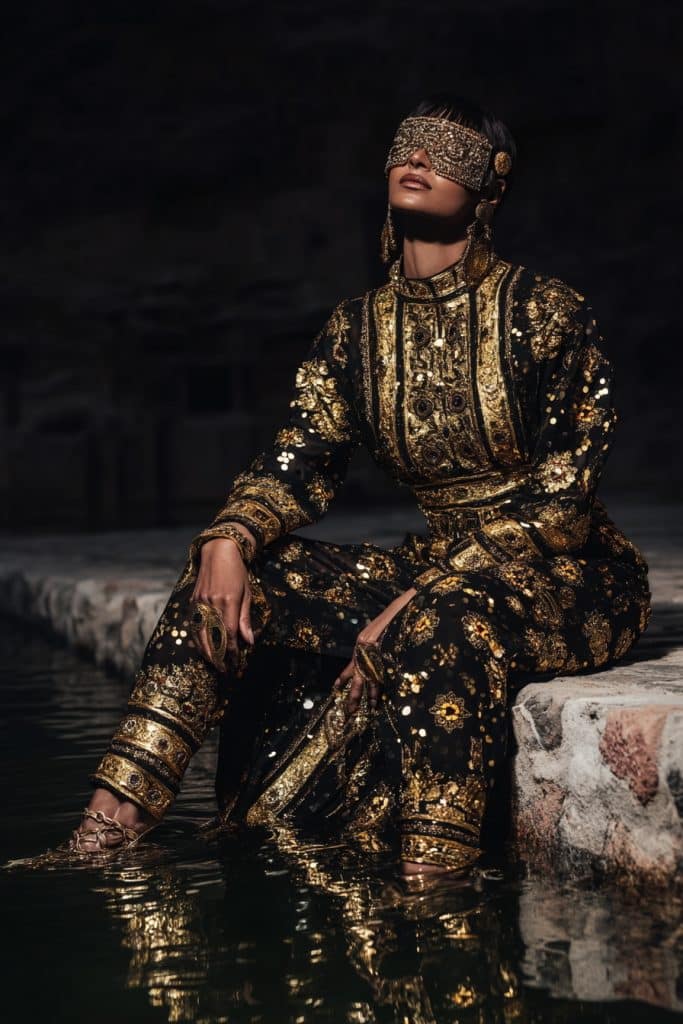
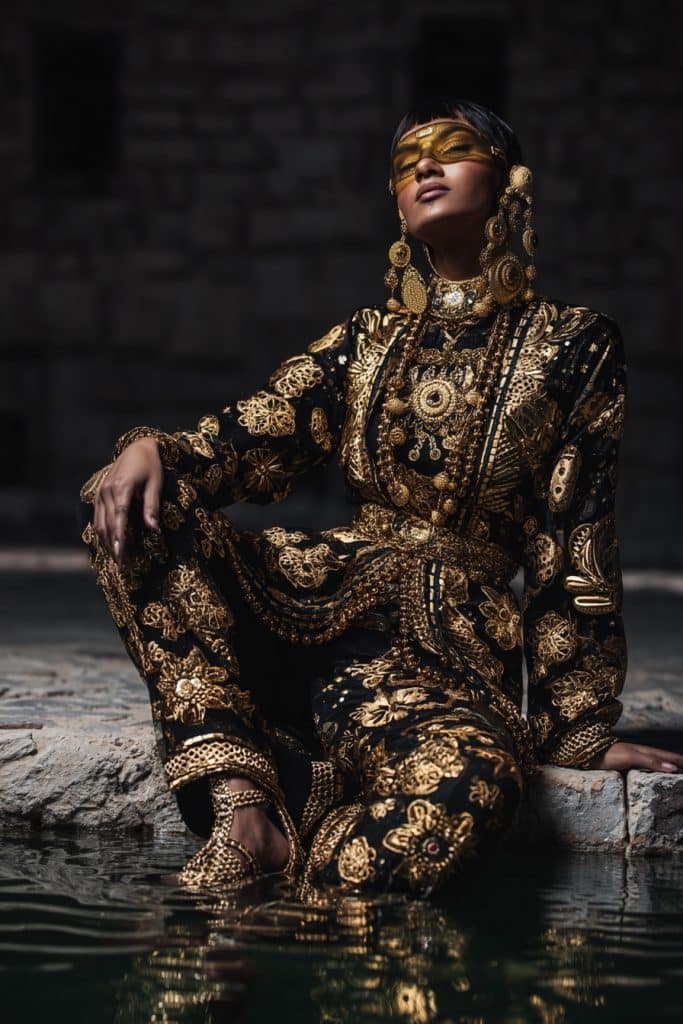
Immerse yourself in the Beauty of the Past to bring Solidity to the Present. AI-generated outfit freely inspired to Emirati Embellished Tunic Dress with Metallic Straw from “The Zay Initiative – Archive”; Image Source: AI-Generated By Gazetta
The Zay Initiative engages in many ways – through exhibitions, educational talks, research, and its digital platforms. The aim is to keep the archive open and accessible, not just for scholars or collectors, but for anyone curious about Arab heritage. Platforms like @thezayinitiative allow to connect with global audiences, especially younger generations, in real time.
Much of the collection can be explored through The Zay’s Digital Archive, where garments are catalogued with their stories, techniques and origins. For those who wish to support the mission more directly, it is possible to become a Friend of The Zay, joining a growing network of advocates and contributors.
“We’ve been fortunate to receive support from ministries, museums, universities, cultural councils, and private patrons. But what truly sustains the Initiative – Dr. El Mutwalli concludes – is a shared belief that these garments are not just beautiful, they are meaningful. They hold history, memory, and identity.
The Zay Initiative is not a solitary effort. It is a collective movement to ensure that what was once worn and lived is not forgotten, but carried forward – thread by thread, story by story.




